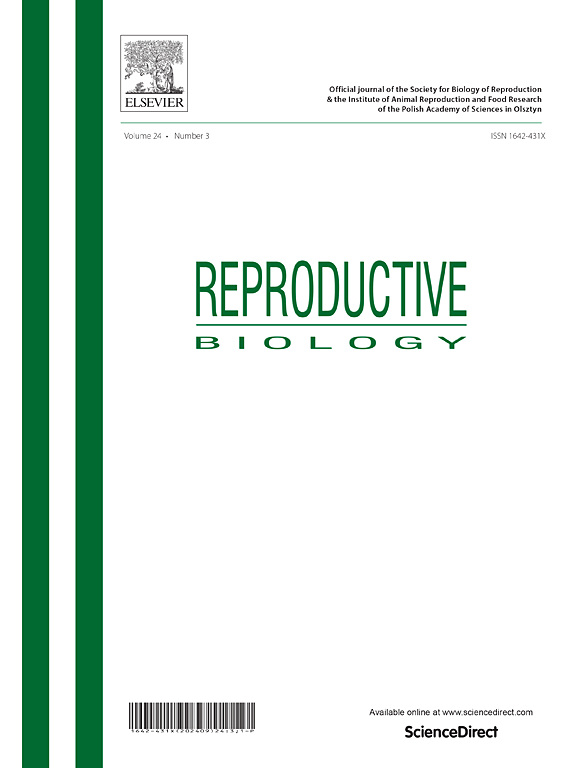研究在体外受精过程中添加细胞外囊泡对 ICSI 后马卵母细胞受精率的影响。
IF 2.5
3区 生物学
Q3 REPRODUCTIVE BIOLOGY
引用次数: 0
摘要
与其他物种相比,马体外胚胎生产(IVEP)的功效相对有限,原因是缺乏可靠的超排卵技术、卵母细胞积聚体(COCs)供应有限、体外卵母细胞成熟(IVM)和受精率较低。细胞外囊泡(EVs)是参与卵巢环境中细胞间信号传导的纳米颗粒,已显示出在体外受精过程中作为改善卵母细胞发育的补充剂的潜力。本研究对来自小卵泡(小于 20 毫米)的 EVs 可提高母马受精率的假设进行了测试。卵泡液是在死后收集的,EVs被分离出来并进行了表征。在有或没有EVs(200微克EV蛋白/毫升)的情况下进行IVM过程。使用荧光标记和共聚焦显微镜检查了IVM过程中EV的内化情况。卵胞浆内精子注射(ICSI)后,在延时系统中培养推定的合子。共聚焦显微镜证实了EV被COCs内化。纳米粒子追踪分析表明,获得的EVs为亚微米大小,流式细胞术在EVs亚群上发现了表面标记CD81和CD63。透射电子显微镜显示,EV 分离物具有特征性的圆盘形状。培养后,196 个卵母细胞(36.84%)出现了第一个极体,并进行了卵胞浆内单精子显微注射。EV处理组的受精率明显更高(34.7 % vs. 20.2 %; P本文章由计算机程序翻译,如有差异,请以英文原文为准。
Investigating the impact of extracellular vesicle addition during IVM on the fertilization rate of equine oocytes following ICSI
The efficacy of in vitro embryo production (IVEP) in equines is relatively limited compared to other species due to the lack of a reliable superovulation technique, limited availability of cumulus oocyte complexes (COCs), low in vitro oocyte maturation (IVM) and fertilization rates. Extracellular vesicles (EVs), which are nanoparticles involved in intercellular signaling in the ovarian environment, have shown potential as supplements to improve oocyte development during IVM. This study tested the hypothesis that EVs from small (< 20 mm) ovarian follicles could enhance fertilization rates in mares. Follicular fluid was collected postmortem, and EVs were isolated and characterized. The IVM process was conducted with or without EVs (200 µg EV protein/ml). EV internalization during IVM was examined using fluorescent labeling and confocal microscopy. Following intracytoplasmic sperm injection (ICSI), presumptive zygotes were cultured in a time-lapse system. Confocal microscopy confirmed EV internalization by COCs. Nanoparticle tracking analysis showed that obtained EVs were submicron-sized, and flow cytometry identified surface markers CD81 and CD63 on a subpopulation of EVs. Transmission electron microscopy revealed the characteristic disk shape of EV isolates. After culture, 196 oocytes (36.84 %) exhibited a first polar body and were subjected to ICSI. The EV-treated group showed a significantly higher fertilization rate (34.7 % vs. 20.2 %; P < 0.05), reduced degeneration, and increased cleavage efficiency (P < 0.1). Despite early embryonic arrest in both groups, these results suggest that follicular fluid-derived EVs could play a supportive role in equine IVF procedures.
求助全文
通过发布文献求助,成功后即可免费获取论文全文。
去求助
来源期刊

Reproductive biology
生物-生殖生物学
CiteScore
3.90
自引率
0.00%
发文量
95
审稿时长
29 days
期刊介绍:
An official journal of the Society for Biology of Reproduction and the Institute of Animal Reproduction and Food Research of Polish Academy of Sciences in Olsztyn, Poland.
Reproductive Biology is an international, peer-reviewed journal covering all aspects of reproduction in vertebrates. The journal invites original research papers, short communications, review articles and commentaries dealing with reproductive physiology, endocrinology, immunology, molecular and cellular biology, receptor studies, animal breeding as well as andrology, embryology, infertility, assisted reproduction and contraception. Papers from both basic and clinical research will be considered.
 求助内容:
求助内容: 应助结果提醒方式:
应助结果提醒方式:


